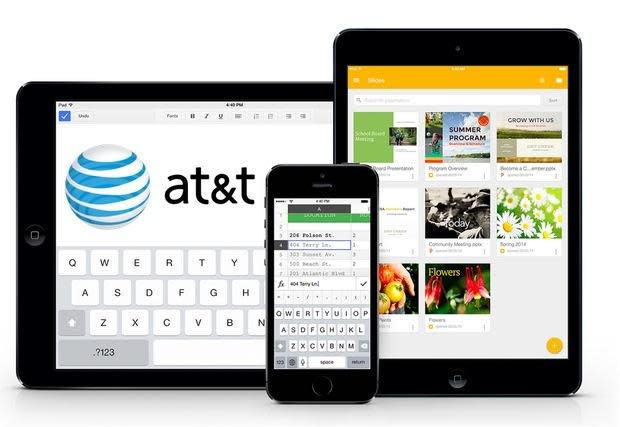How to buy iPhones and iPads with AT&T Next and Mobile Share plans

This past week, my wife and I stayed with my father and his family for a week, which included him, my stepmother, and two younger brothers. He has been an AT&T customer for years and was struggling to understand how the company's new Mobile Share Value Plans worked.
I realized that while AT&T's newer plans are an excellent value for families, particularly those with a number of devices, the company has not done the best job explaining its plans. So, I helped my dad pick out the best plan for him, and I'm here to help you as well.
Back in the day, iPhone buyers would simply choose how many monthly voice minutes and text messages they wanted to use because they had unlimited data.
Then, AT&T got rid of unlimited data, and there were three decisions to make: voice minutes, data allotment, and text messaging.
Now, choosing a smartphone data plan is much easier. Smartphone users are using much less voice minutes these days, and competition has driven down the cost of text messaging. As a result, AT&T now offers unlimited talk and text to most of its customers, which means that there's only one choice left: how much data to use.
For users on an AT&T family plan (and you should get on one if you can, even if you need to link up with some trusted friends, because there's huge savings to be had), data is purchased in one large monthly bucket, and all devices draw off that bucket.
There is a base charge for that data, and then individual devices are added on top of it.
This week, AT&T launched a new promotion that gives 15 GB of monthly data for $100, what it used to charge for just 10 GB. This is on top of another promo (ending soon) that sees data allotments doubled for 15 GB and up data plans.
So, first, buyers need to choose how much data they use. It's also important to note that while AT&T's data plan promos must be purchased before they expire, buyers can keep their data plans as long as they don't try to change them.
At the moment, here's how much AT&T charges for its monthly data buckets. Though there are smaller plans, plans with 10 GB of data or more are the best deals. Choose one:
15 GB (with promotion, normally 10 GB) - $100 per month
30 GB (15 GB) - $130
40 GB (20 GB) - $150
60 GB (30 GB) - $225
80 GB (40 GB) - $300
100 GB (50 GB) - $375
This data bucket is shared between all devices on the account, up to 10 in total. All plans include unlimited talk and text, including international text messaging, as well as support for personal hotspots to share connections with other Wi-Fi devices.
Next, it's time to decide how many devices you want. Because AT&T is moving away from subsidizing its phones and tablets, choosing instead to direct customers to its AT&T Next 0% financing service, pricing is much simpler and straightforward.
Tablets and cars with built-in cellular connections are $10/month, smartphones are $15/month, and MiFi dedicated hotspots are $20/month, plus tax.
This means that my wife and I, with two iPhones and two cellular iPads between us, pay $150 per month plus tax for a 10 GB per month plan. This is nearly $100 less per month than we paid just a couple of years ago.
Finally, we come to how to buy your phones. There are two choices, 0% financing with AT&T Next, where you can spread the cost of a purchase over many months, or buying the phone outright, unsubsidized.
Buying the phone outright allows you to have an unlocked phone, usable on any GSM network in the world, and you can avoid signing any contracts or commitments. However, it also requires upfront payments ranging from $650-$950 for Apple's latest and greatest devices.
AT&T Next is a 0% financing plan for qualified buyers, similar to buying a bedroom set or a car -- you pay the full price of the phone over a number of months but without any additional fees for spreading out the payments.
There are a number of options for Next, depending on how much you want to pay per month. There are 20, 24, and 30 installment plans, with monthly pricing determined by dividing the full price of the phone by those amounts. For example, a 64 GB iPhone 6 costs $749, so it would cost $37.50, $31.25, or $25/month on the three installment plans. The amount paid is identical across all three, it merely determines how long you'll be on the hook for the phone.
Buyers can also choose to pay off their phone in full at any time, at which time they can get it unlocked by AT&T for use on other carriers or for resale.
So, while it's complicated, AT&T's family plans can save buyers a lot of money, and they can even be used by very small businesses to provide phones and tablets for their employees, with up to 10 devices per Mobile Share data bucket.
So, to recap:
Choose how much data you want
Choose how many devices you want to add to the plan
Choose how you want to pay for those devices, either financed with no penalties or fees (assuming you pay on time) or paid in full
AT&T retains a bad rap for having overpriced plans, but it has made great strides in recent years to reduce its costs, particularly for families. It's worth looking into for anyone with multiple devices.
Have you tried AT&T's new Mobile Share plans? Let us know about your experience in the comments below.

